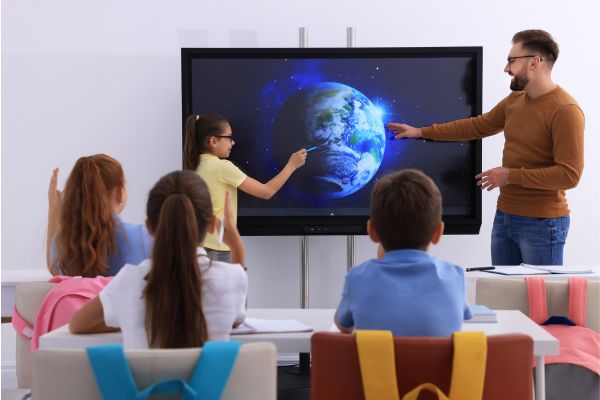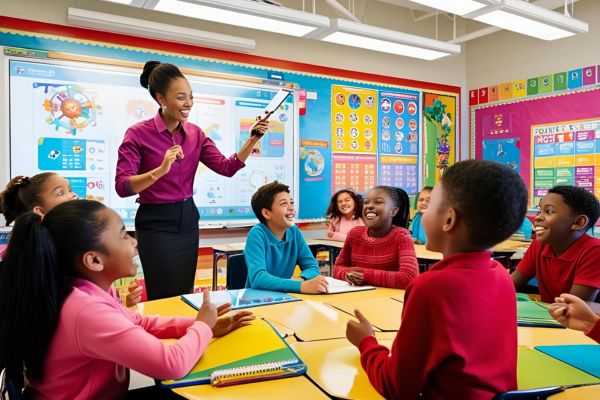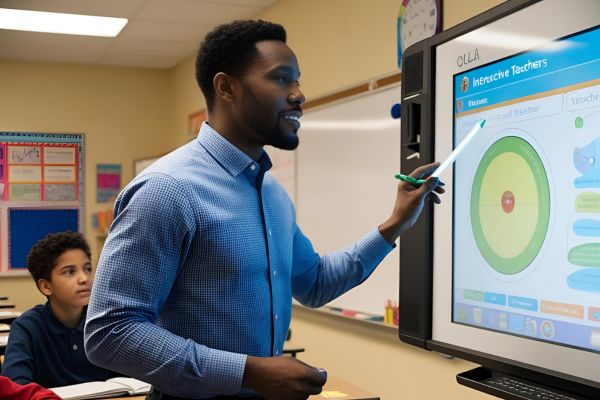Traditional classrooms have long relied on chalkboards and static presentations, but as education evolves, so do the tools that enhance learning. Interactive whiteboards (IWBs) have emerged as a game-changer in modern education, transforming classrooms into dynamic, tech-driven spaces where students actively engage with lessons. These digital tools integrate multimedia, real-time collaboration, and interactive elements, making learning more immersive and effective.
With studies showing that interactive learning boosts student engagement by up to 60%, schools worldwide are embracing IWBs to enhance participation, improve retention, and cater to different learning styles. Whether used for visualizing complex concepts, facilitating group activities, or enabling remote learning, interactive whiteboards are reshaping the educational landscape.

What Are Interactive Whiteboards?
Interactive whiteboards (IWBs) are digital display tools that combine a traditional whiteboard with advanced technology, allowing teachers and students to interact dynamically with digital content. These tools enable real-time collaboration, multimedia integration, and hands-on learning, making classroom lessons more engaging and immersive.
How Interactive Whiteboards Are Transforming Classroom Learning
Encouraging Student Participation
Interactive whiteboards create a more inclusive learning environment by encouraging active student participation. Unlike traditional teaching methods, where students passively receive information, IWBs allow them to engage directly by writing, drawing, or interacting with digital elements. Features like touch-based navigation, quizzes, and interactive exercises make lessons more dynamic, fostering enthusiasm for learning.
Enhancing Visual and Multimedia Learning
One of the biggest advantages of interactive whiteboards is their ability to integrate multimedia content seamlessly. Teachers can display videos, animations, infographics, and real-time simulations to explain complex concepts in an easy-to-understand manner. Studies show that visual aids improve information retention by up to 65%, making IWBs an effective tool for long-term learning.
Supporting Collaborative Learning
Interactive whiteboards promote teamwork and peer collaboration in classrooms. Students can work together on group projects, solve problems, and participate in brainstorming sessions directly on the board. This fosters critical thinking, problem-solving skills, and teamwork, preparing students for real-world challenges.

Catering to Different Learning Styles
Not all students learn the same way. Some grasp concepts better through visuals, while others prefer hands-on activities or auditory explanations. Interactive whiteboards cater to diverse learning styles by allowing teachers to incorporate a mix of text, images, videos, and interactive elements, ensuring that every student benefits from the lesson.
The Benefits of Interactive Whiteboards for Teachers
Simplifying Lesson Planning and Delivery
Teachers can save time by preparing interactive lessons in advance, incorporating multimedia elements, and organizing lesson structures efficiently. With the ability to store and retrieve digital lessons, educators can streamline the teaching process while maintaining consistency in lesson delivery.
Instant Feedback and Assessment
With built-in assessment tools, interactive whiteboards allow teachers to conduct real-time quizzes, polls, and instant feedback sessions. This enables educators to gauge student understanding on the spot and adjust their teaching approach accordingly. Research indicates that instant feedback improves student performance by up to 30%, highlighting the effectiveness of real-time assessments.

Remote and Hybrid Learning Compatibility
As education continues to evolve, remote and hybrid learning have become more common. Interactive whiteboards support online collaboration tools, video conferencing, and cloud-based lesson sharing, making them an essential tool for modern classrooms. Students can participate in interactive lessons from anywhere, bridging the gap between in-person and remote education.
Overcoming Challenges in Implementing Interactive Whiteboards
Despite their numerous advantages, implementing this comes with challenges, such as initial costs, teacher training, and maintenance. However, many schools and educational institutions are investing in government grants and technology funding to make these tools more accessible. Additionally, ongoing professional development programs help teachers maximize the potential of IWBs.
The Future of Interactive Whiteboards in Education
With advancements in artificial intelligence, augmented reality, and cloud-based learning, the future of interactive whiteboards looks promising. AI-powered whiteboards will soon be able to analyze student responses and personalize lesson plans accordingly, enhancing the overall learning experience. As technology continues to shape education, interactive whiteboards will remain a vital tool in classrooms worldwide.




